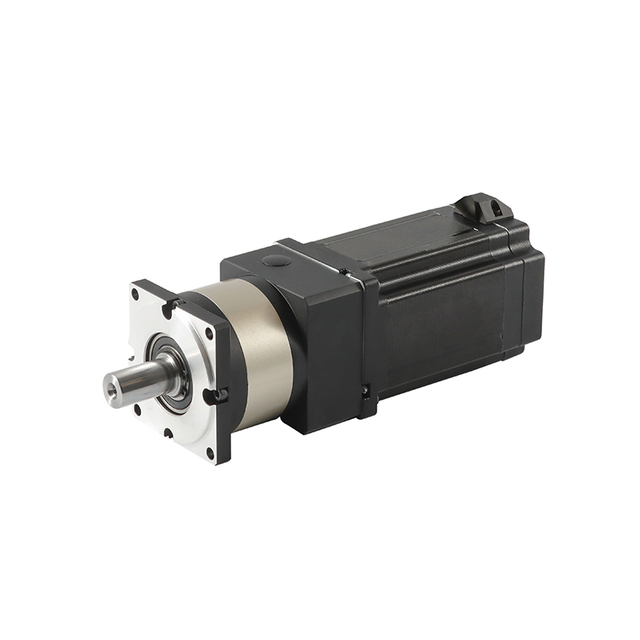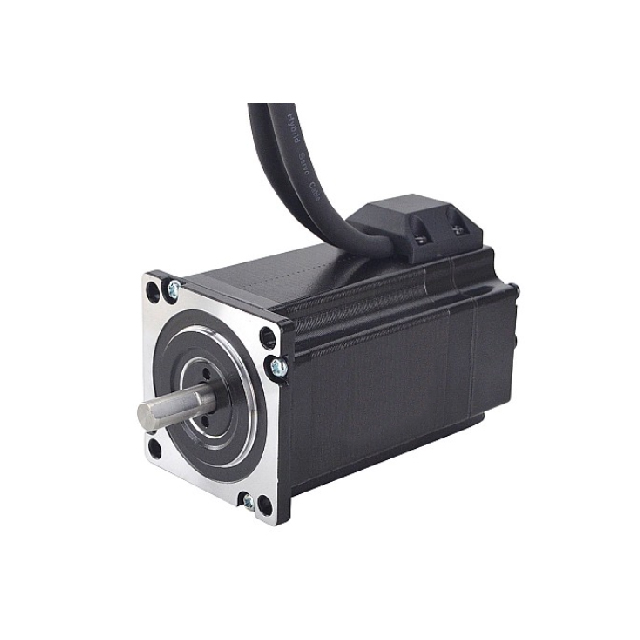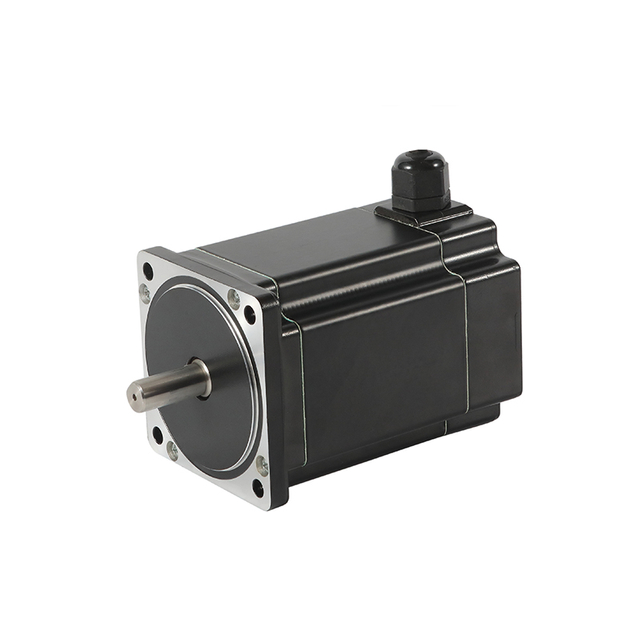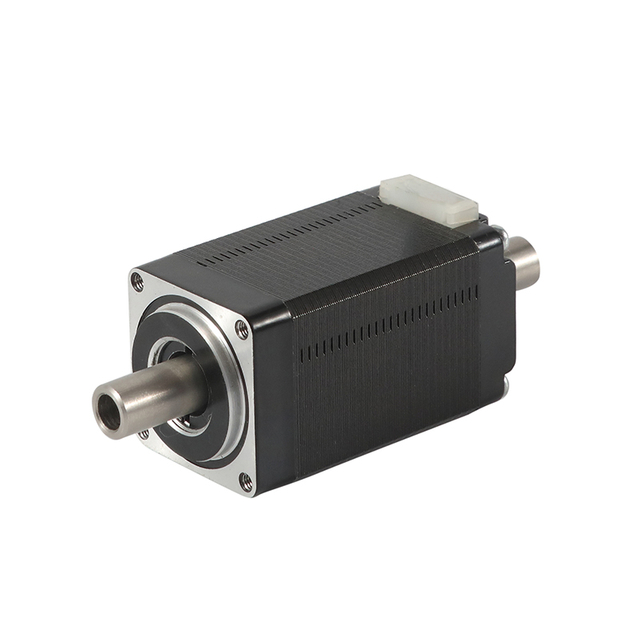
Stepper motors are renowned for their precision, reliability, and robustness, but like all electromechanical components, they have limits. When these limits are exceeded—through misuse, poor design, or neglect—stepper motors can suffer irreversible damage. Understanding what can destroy a stepper motor is essential for engineers, technicians, and automation professionals seeking long-lasting performance and efficiency in their systems.
1. Overheating: The Silent Killer of Stepper Motors
Overheating is one of the most common and destructive problems faced by stepper motors. While these motors are designed to handle continuous operation, excessive heat can silently degrade their internal components until complete failure occurs.
When a stepper motor overheats, several internal issues arise — insulation breakdown, magnet demagnetization, and bearing wear. Over time, these problems reduce the motor's torque output, accuracy, and overall lifespan.
Causes of Overheating
Excessive Current Settings
Stepper motors draw current continuously, even when stationary. If the driver is set to deliver more current than the motor's rated value, the windings can heat up rapidly. Sustained overcurrent leads to insulation melting and permanent coil damage.
Poor Ventilation or Cooling
Operating a motor in an enclosed or unventilated environment prevents heat from escaping. Without proper airflow or heat dissipation, temperatures can quickly exceed safe limits.
High Ambient Temperature
When stepper motors are used in hot industrial environments, the surrounding air cannot effectively absorb heat from the motor body, resulting in rising internal temperatures.
Incorrect Driver Configuration
Using a driver without current limiting or misconfigured microstepping can increase power loss as heat, putting additional thermal stress on the coils.
Consequences of Overheating
Winding Insulation Breakdown: Once insulation melts, short circuits form between coils, causing erratic behavior or complete motor failure.
Permanent Magnet Demagnetization: Excessive heat weakens the rotor magnets, drastically reducing torque output.
Bearing Damage: Heat expands metal parts, increasing friction and causing premature bearing wear or seizure.
Once these conditions occur, performance degradation is irreversible—even if the motor cools down.
How to Prevent Overheating
Set the correct current limit on your stepper driver according to the motor's rated current.
Add heatsinks or cooling fans to improve thermal dissipation.
Use idle current reduction features in modern drivers to lower holding current when the motor is stationary.
Monitor motor temperature with thermal sensors or infrared thermometers during prolonged use.
Select motors with higher current or torque ratings when operating under demanding loads.
By implementing these measures, you can prevent thermal stress, ensuring your stepper motor runs cool, efficient, and reliable for years of operation.
2. Overvoltage and Electrical Surges
Overvoltage and electrical surges are among the most destructive electrical conditions that can instantly damage or shorten the lifespan of a stepper motor. While stepper motors are built to handle precise, controlled voltage pulses, exposure to voltage levels beyond their design limits can lead to coil insulation failure, driver damage, and catastrophic motor burnout.
What Causes Overvoltage?
Incorrect Power Supply Connection
Using a power supply with a voltage rating higher than the motor or driver specification can cause excessive current flow through the coils. This not only overheats the windings but also stresses the insulation, leading to short circuits.
Inductive Voltage Spikes (Back-EMF)
Stepper motors generate back electromotive force (back-EMF) when decelerating or stopping abruptly. If not properly managed, this voltage can surge back into the driver circuit, damaging both the motor and the control electronics.
Power Surges from the Mains
Electrical transients caused by lightning, power grid fluctuations, or other equipment switching on the same line can inject sudden voltage spikes into the system.
Faulty or Unregulated Power Supplies
Cheap or poorly regulated power supplies may deliver unstable output voltage, causing repetitive surges that gradually weaken the motor insulation over time.
How Overvoltage Destroys a Stepper Motor
Insulation Breakdown: Excess voltage exceeds the dielectric strength of coil insulation, leading to short circuits between windings.
Driver Circuit Damage: Surges feed back into the control driver, destroying MOSFETs or transistors that regulate current.
Magnet Degradation: High voltage can generate internal heating, causing the rotor magnets to lose strength and reducing torque output.
Electrical Arcing: Extreme voltage may cause arcing across terminals or connectors, resulting in carbon buildup and intermittent faults.
Even a brief overvoltage event can cause instant failure, and repeated minor surges gradually degrade performance until the motor becomes unreliable.
How to Prevent Overvoltage and Surges
Use a Regulated Power Supply
Always use a high-quality, regulated power supply that maintains a stable voltage level under varying loads. Avoid unverified low-cost adapters.
Install Surge Protection Devices
Incorporate TVS (Transient Voltage Suppression) diodes, varistors, or snubber circuits across the motor terminals. These components absorb sudden voltage spikes, protecting both the motor and driver electronics.
Add Flyback Diodes or Suppression Circuits
For systems with inductive loads, flyback diodes safely redirect excess voltage energy back into the circuit, preventing surges from reaching sensitive components.
Enable Dynamic Braking or Regenerative Circuits
During rapid deceleration, regenerative voltage can build up. Using dynamic braking or energy-dissipation circuits helps manage excess energy safely.
Proper Grounding and Shielding
Ground the motor and control circuits correctly. Shield signal and power lines to minimize electrical noise and interference that can induce transient spikes.
Best Practices for Safe Operation
Match the motor voltage rating with the driver and power supply specifications.
Avoid rapidly switching power on and off without allowing capacitors to discharge.
Use soft-start power circuits to prevent high inrush currents.
Regularly inspect connectors, wiring, and grounding systems to ensure there are no loose or corroded contacts.
When managed properly, voltage control not only protects your stepper motor but also ensures consistent torque, smooth operation, and extended service life. Preventing overvoltage and surges is not just about avoiding immediate failure—it's about maintaining long-term reliability and precision in your motion control systems.
3. Mechanical Overload and Shaft Misalignment
Mechanical overload and shaft misalignment are two of the most common mechanical causes of stepper motor failure. Even though stepper motors are engineered for high precision and durability, excessive load or improper mechanical alignment can lead to bearing wear, shaft deformation, rotor damage, and premature breakdown. Understanding these factors is critical to maintaining long-term motor performance and accuracy.
What Is Mechanical Overload?
Mechanical overload occurs when the torque demand placed on the motor exceeds its rated capacity. When this happens, the motor struggles to move the load, drawing excessive current and generating excess heat. Prolonged overload can overstress the bearings, wear out the rotor shaft, and cause step loss or complete stalling.
Common Causes of Mechanical Overload
Heavy or Unbalanced Loads – Loads that exceed the motor's rated torque create excessive resistance during motion.
Sudden Acceleration or Deceleration – Rapid motion changes introduce torque spikes that can strip couplings or deform the shaft.
Improper Gear Ratios – Using gear systems with incorrect ratios increases mechanical stress on both motor and drivetrain.
Over-Tensioned Belts and Pulleys – Excess belt tension applies unwanted radial load on the motor bearings, leading to friction and premature wear.
Long Operating Durations Under Maximum Load – Continuous high-torque operation without cooling or rest periods accelerates mechanical fatigue.
When overloaded, the motor can lose synchronization, skip steps, or even seize entirely—signs that mechanical forces are exceeding its design limits.
What Is Shaft Misalignment?
Shaft misalignment happens when the motor shaft is not perfectly aligned with the driven load (such as a lead screw, pulley, or coupling). Even a small angular or parallel misalignment can lead to vibration, friction, and axial stress, causing severe wear over time.
Types of Shaft Misalignment
Angular Misalignment – The motor shaft and load shaft meet at an angle instead of being parallel.
Parallel (Offset) Misalignment – The two shafts are parallel but not in the same line, causing eccentric rotation.
Axial Misalignment – The shafts are not properly spaced along the same axis, leading to push-pull stress on bearings.
Misalignment creates oscillating forces on the bearings and couplings, resulting in heat buildup, vibration, and eventual bearing failure.
Effects of Overload and Misalignment on Stepper Motors
Bearing Damage: Excessive radial or axial loads wear down bearing surfaces, leading to noise, vibration, and motor binding.
Shaft Deformation: Persistent overload or misalignment can bend or warp the motor shaft, reducing torque and alignment accuracy.
Rotor-Stator Contact: When the shaft or bearings wear excessively, the rotor can scrape the stator, permanently damaging internal components.
Increased Vibration and Noise: Overload and misalignment amplify vibration, which can loosen fasteners, cause resonance, and shorten component lifespan.
Reduced Torque and Positioning Accuracy: Mechanical friction and drag reduce available torque and cause missed steps, leading to loss of precision.
How to Prevent Mechanical Overload
Size the Motor Correctly
Choose a stepper motor with sufficient torque and current ratings to handle the maximum expected load. Always account for safety margins and acceleration torque.
Use Gear Reduction or Torque Multipliers
Employ gearboxes or timing belts to distribute mechanical stress more effectively and reduce direct strain on the motor shaft.
Implement Smooth Motion Profiles
Avoid abrupt starts and stops by using controlled acceleration and deceleration ramps in your motion control program.
Monitor Load Conditions
Integrate sensors to detect overload or stall conditions. Modern closed-loop stepper systems can automatically adjust current to prevent damage.
How to Prevent Shaft Misalignment
Use Flexible or Helical Couplings
These couplings can absorb small angular and parallel misalignments, reducing stress transmission to the motor shaft.
Align Components Precisely
Use alignment tools or laser alignment systems to ensure shafts are perfectly centered before tightening couplings.
Avoid Over-Tightening Bolts and Mounts
Over-tightened mounts can distort motor housing or alter alignment under load.
Regularly Inspect Mounting Hardware
Vibration and operational stress can loosen bolts and brackets over time, gradually introducing misalignment.
Maintain Proper Bearing Lubrication
Lubricated bearings minimize friction and heat, extending motor life even under minor alignment imperfections.
Symptoms of Overload or Misalignment
Increased motor noise or vibration during operation.
Erratic movement or missed steps.
Heat buildup in the motor housing or bearings.
Visible shaft wobble or uneven wear on coupling components.
Reduced positioning accuracy or inconsistent motion profiles.
When these symptoms appear, immediate inspection is essential. Continuing operation under these conditions can lead to irreversible mechanical failure.
Conclusion
Mechanical overload and shaft misalignment are often overlooked, yet they can silently destroy a stepper motor's mechanical integrity. Proper motor sizing, load balancing, alignment precision, and preventive maintenance are the best defenses against these failures. By addressing these issues proactively, you can ensure your stepper motor operates smoothly, quietly, and efficiently, delivering the precision and reliability your system demands.
4. Driver Mismatch or Incorrect Wiring
A stepper motor is only as reliable as its driver configuration. Using the wrong driver type, incorrect phase wiring, or mismatched voltage/current settings can cause erratic motion, overheating, and failure.
Driver Mismatch Issues
Underpowered drivers cause missed steps and loss of torque.
Overpowered drivers risk overcurrent and coil burnout.
Incompatible microstepping settings can cause resonance or uneven movement.
Incorrect Wiring Symptoms
The motor vibrates but doesn't rotate.
The motor heats up instantly upon power-up.
Unstable or oscillating behavior at certain speeds.
Always verify coil pair connections and phase order using a multimeter before powering the system. Using matched drivers from reputable manufacturers ensures the current and voltage are properly regulated.
5. Resonance and Vibration Damage
Stepper motors operate in discrete steps, which can induce mechanical resonance—a phenomenon where vibration frequency matches the motor’s natural frequency. When resonance occurs, torque output drops, and vibrations can physically damage motor components over time.
Causes of Resonance
Operating at certain step frequencies (typically 50–200 Hz).
Lack of damping in mechanical mounting.
Stiff couplings or structural vibrations amplifying motion.
How to Prevent Resonance
Implement microstepping drivers to smooth motion profiles.
Add rubber dampers or vibration isolators between motor and frame.
Adjust acceleration/deceleration ramps to avoid resonant speed ranges.
Prolonged resonance can lead to bearing failure, loosened fasteners, and even rotor magnet degradation.
6. Environmental Factors and Contamination
Stepper motors are sensitive to dust, moisture, and corrosive substances. When foreign materials enter the housing, they interfere with the rotor, bearings, or windings, leading to friction and electrical shorting.
Environmental Risks
Dust and debris cause bearing wear and jamming.
Moisture and humidity lead to rust and insulation breakdown.
Chemicals and solvents corrode internal components and seals.
Preventive Measures
Use sealed or IP-rated stepper motors in harsh environments.
Implement protective housings with desiccant packs or air purging.
Regularly inspect and clean motors operating in dusty or wet conditions.
Neglecting environmental protection can lead to seized shafts, short circuits, and total motor failure.
7. Improper Acceleration and Deceleration Ramps
Stepper motors cannot instantly jump from zero to full speed. Doing so causes step loss, stalling, and mechanical shock. Repeated over-acceleration can destroy both the motor and its mechanical load.
Why It Happens
Controllers without ramp generation accelerate too quickly.
Loads with high inertia resist sudden movement.
Improper programming of motion profiles.
Solutions
Use acceleration and deceleration ramps in motion control algorithms.
Gradually ramp speed up and down based on load inertia.
Employ closed-loop stepper systems with feedback to detect stalls.
Without proper control, the rotor loses synchronization with the magnetic field, resulting in overcurrent spikes and mechanical stress fractures.
8. Continuous Stalling and Step Loss
Running a motor beyond its torque capacity leads to stalls, where the rotor fails to follow the commanded steps. Persistent stalling generates excessive current and heat, damaging both the motor and driver.
Indicators of Stalling
The motor buzzes but doesn't move.
Rapid torque drop at higher speeds.
Irregular position or skipped steps.
Prevention
Keep operation within the torque-speed curve.
Use closed-loop feedback systems for load detection.
Avoid sudden load variations that exceed motor torque.
Ignoring stalls not only reduces precision but can also burn out windings over time.
9. Static Holding for Extended Periods
When a stepper motor holds position, current continues to flow through its windings to maintain torque. If left energized for long durations without motion, thermal buildup can occur even without rotation.
Best Practices
Reduce holding current using driver idle current reduction features.
Disable motor power when holding torque is not required.
Employ brake mechanisms for static loads instead of constant current hold.
Continuous holding without cooling can cause gradual insulation decay and premature coil failure.
Conclusion
A stepper motor's longevity depends on careful design, proper configuration, and regular maintenance. The leading causes of destruction—overheating, overvoltage, mechanical stress, poor wiring, and environmental contamination—are entirely preventable with proper engineering practices. By respecting rated parameters and implementing protective measures, stepper motors can deliver years of precise, reliable performance.
English
العربية
Français
Русский
Español
Português
Deutsch
italiano
日本語
한국어
Nederlands
Tiếng Việt
ไทย
Polski
Türkçe
ພາສາລາວ
ភាសាខ្មែរ
Bahasa Melayu
ဗမာစာ
Filipino
Bahasa Indonesia
magyar
Română
Čeština
Монгол
қазақ
Српски
हिन्दी
فارسی
Slovenčina
Slovenščina
Norsk
Svenska
українська
Ελληνικά
Suomi
Հայերեն
עברית
Latine
Dansk
Shqip
বাংলা
Hrvatski
Afrikaans
Gaeilge
Eesti keel
Oʻzbekcha
latviešu
Azərbaycan dili
Български
Català










